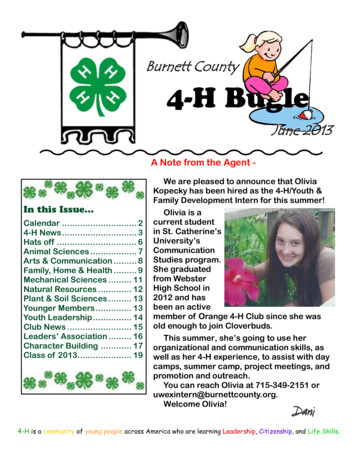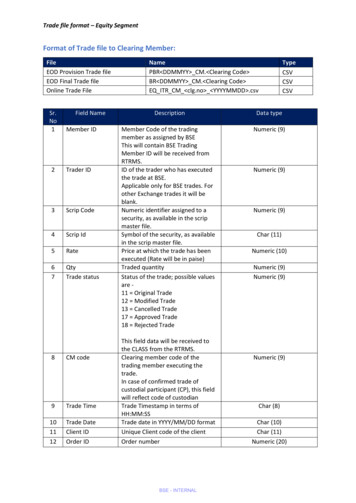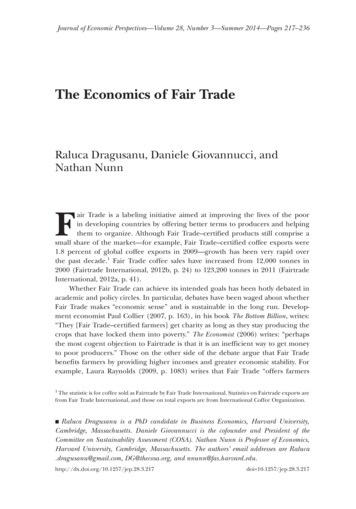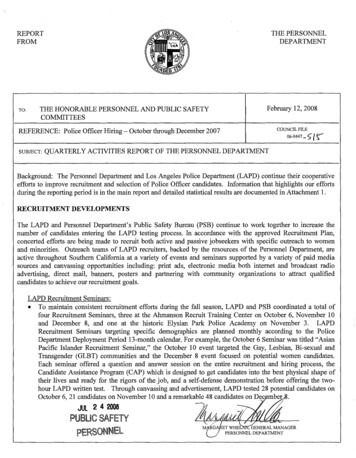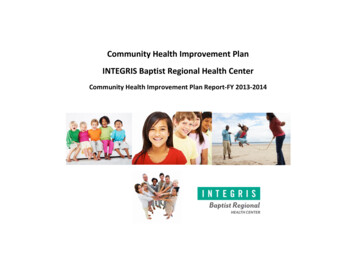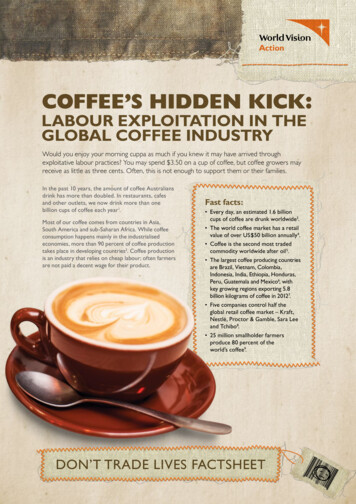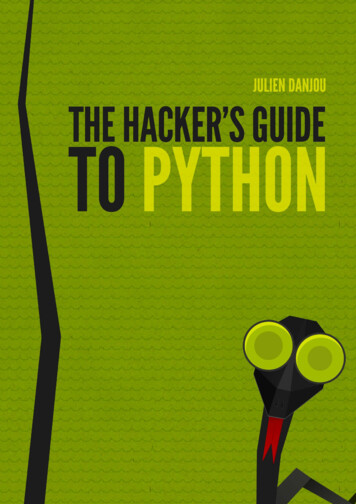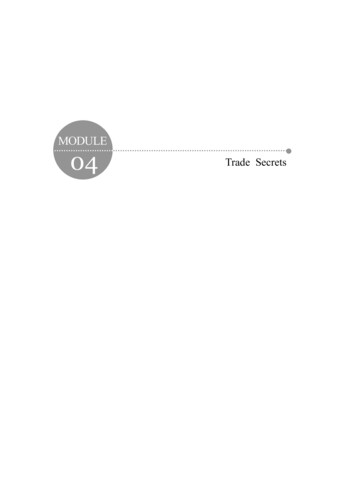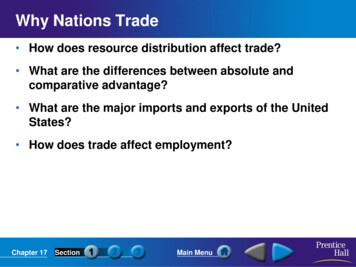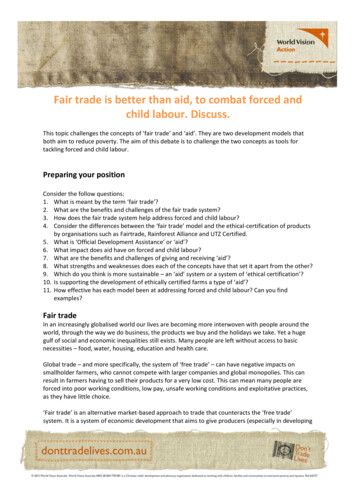
Transcription
Fair trade is better than aid, to combat forced andchild labour. Discuss.This topic challenges the concepts of ‘fair trade’ and ‘aid’. They are two development models thatboth aim to reduce poverty. The aim of this debate is to challenge the two concepts as tools fortackling forced and child labour.Preparing your positionConsider the follow questions:1. What is meant by the term ‘fair trade’?2. What are the benefits and challenges of the fair trade system?3. How does the fair trade system help address forced and child labour?4. Consider the differences between the ‘fair trade’ model and the ethical-certification of productsby organisations such as Fairtrade, Rainforest Alliance and UTZ Certified.5. What is ‘Official Development Assistance’ or ‘aid’?6. What impact does aid have on forced and child labour?7. What are the benefits and challenges of giving and receiving ‘aid’?8. What strengths and weaknesses does each of the concepts have that set it apart from the other?9. Which do you think is more sustainable – an ‘aid’ system or a system of ‘ethical certification’?10. Is supporting the development of ethically certified farms a type of ‘aid’?11. How effective has each model been at addressing forced and child labour? Can you findexamples?Fair tradeIn an increasingly globalised world our lives are becoming more interwoven with people around theworld, through the way we do business, the products we buy and the holidays we take. Yet a hugegulf of social and economic inequalities still exists. Many people are left without access to basicnecessities – food, water, housing, education and health care.Global trade – and more specifically, the system of ‘free trade’ – can have negative impacts onsmallholder farmers, who cannot compete with larger companies and global monopolies. This canresult in farmers having to sell their products for a very low cost. This can mean many people areforced into poor working conditions, low pay, unsafe working conditions and exploitative practices,as they have little choice.‘Fair trade’ is an alternative market-based approach to trade that counteracts the ‘free trade’system. It is a system of economic development that aims to give producers (especially in developing
countries) a living wage and enable them to make better trading conditions and promotesustainability.Ethical certification (through organisations such as Fairtrade, Rainforest Alliance and UTZ Certified) isa process by which assurances can be made that products are traded fairly.There are many demonstrated examples of farmers and farming communities receiving higher, moresustainable incomes as a result of the ‘fair trade’ system. However ‘fair trade’ is not withoutcriticism. For example, some claim that the cost of establishing community-based co-operatives istoo high for many farming communities to become involved and therefore they are even furtherisolated from the market.AidOfficial Development Assistance – more commonly known as ‘international aid’ or ‘development aid’or simply ‘aid’ – is the voluntary transfer of funds or resources from one country to another. Mostdeveloped countries now give aid to a number of developing countries. These funds are thenavailable for a wide variety of humanitarian projects. This can include projects specifically targetedat combating forced and child labour, or other issues that underpin an individual’s vulnerability toexploitation, such as access to education.Aid tends to be delivered in a number of forms, including:Bilateral aid – when one government gives money directly to another government. They will worktogether to design a programme that aims to reflect both the country’s development needs and thedonor country’s capacity to provide technical or financial assistance.Multilateral aid – when the donor government gives money through international agencies, such asthe World Bank, World Health Organisation or World Food Programme. This allows donor countriesto contribute to large-scale projects and can provide technical expertise beyond individualgovernment’s capacity.Humanitarian emergency relief – provides emergency assistance in a disaster or conflict situation,and helps vulnerable countries prepare for future emergency situations.NGO partnership support – when donor countries provide funds to NGOs, such as World Vision, todeliver community level programs.Technical support and community involvement –when the donor government provides funds forexpert volunteers to work in developing countries, to build the skills and capacities of partnergovernments and organisations; or to develop education programs for the Australian public.While aid is often driven by humanitarian agendas to support those who have less, aid receivescriticism too. Donor government’s are criticised for protecting national interests and prioritising aidto countries of strategic political value to them. Some say aid also creates a culture of dependencyfor poor nations.
Further reading and resources include:NewsAfghan Child Labour fears grow as aid dries n-children-idUSTRE81611020120207Reports and PapersWorld Vision’s Kochore Area Development Programme:www.worldvision.com.au/Libraries/3 3 1 Gender and Development/Toward sustainable development - Kochore ADP in Ethiopia.pdfWorld Vision’s Effective Aid: Helping Millions AReport Effective Aid 2011.sflb.ashxVideoOverseas aid: n Australian view: www.youtube.com/watch?v wftbo3RxGvsOne Just World Forum: Are we fixing world poverty? (Filter past forums for Aid Effectiveness towatch Kevin Rudd’s presentation): www.onejustworld.com.auAid or Trade - Development meets business in Africa: www.youtube.com/watch?v g9b-SYl2nmwIs aid killing Africa? Damisa Moyo talks about Dead Aid on ABC:www.youtube.com/watch?v HIPvlQOCfAQMake Poverty History - A video interviewing Fairtrade certified sources/videos/More Aid, Better Aid – Micah Challenge: www.micahchallenge.org.au/dvdWebsitesAusAID, The Australian Government’s overseas aid program: www.ausaid.gov.auFair Trade Association - An ethical certification scheme: www.fta.org.auISEAL Alliance – A standardization body for ethical certification schemes: www.isealalliance.orgRainforest Alliance - An ethical certification scheme: www.rainforest-alliance.orgUTZ Certified - An ethical certification scheme: www.utzcertified.org
World Vision’s opinionWorld Vision believes that in order to fully address the complex issues of forced and child labour,there is a need for a multi-faceted response that challenges the systems and structures thatunderpin forced and child labour. This includes, but is not limited to, economic development andhumanitarian support through fair trade, and Overseas Development Assistance.Poverty is one of the factors that make people vulnerable to exploitation. Discriminatory practices, alack of money and limited access to employment opportunities, education and life-skills are allfactors that contribute to pushing people into situations where they are at risk of exploitation.Official Development Assistance can help break the link between poverty and exploitation. Aid alonewill not solve all problems, but equally, aid has been a critical driver of many global successes. Itprovides additional resources to low income countries and countries in crisis, and focuses on thepoorest and most marginalised groups who are often vulnerable to forced or child labour.Ethical certification, which relies on independent and transparent third part auditing, is the mostcredible assurance that a product is not made using forced and child labour. Ethical certificationschemes offer a safeguard against abuses and exploitation of workers, for example in regards tominimum wages and safe working conditions. They promote transparency of a company’s practiceswhen engaging with community-based workers, and reassure the public that the company is sociallyresponsible.Trade that is fair to all, that gives local producers a fair chance of economic sustainability rather thancompeting against global monopolies, has multiple social and economic benefits. Increasing worker’sskills and knowledge enables them to cut out middle men in the production and selling of theirproduct; reduce crop loss through wastage and subsequently vastly increase profits. It meansworkers and communities can sustainably manage the development of their own product andbusiness, based on the skills gained. In World Vision’s experience, farmers involved in fair tradeprojects experience better standards of living than they had done previously.Empowering people to lift themselves out of poverty, to create opportunities for themselves and tobe educated about and to advocate for their rights, is a crucial part in reducing people’s vulnerabilityto forced and child labour. Aid donations can fund projects that support this work.
Take Action1. Share World Vision Australia’s video Overseas aid: An Australian ViewTeach others about the importance of overseas aid and share this video via social media and screenit at events.www.youtube.com/watch?v wftbo3RxGvs2. Vote with your dollar! Buy ethically certified products and encourage others in yourcommunity to do the same.Understand your role as a consumer, as an investor, as a voter or as an influencer. This factsheetshows how you can make a difference.www.worldvision.com.au/Libraries/DTL fact sheets/Forced and child labour is everyone s business.pdfUse the Ethical Consumer Guide to help you decide which products to buy.www.ethical.org.auConsider the gift that keeps on giving and purchase from World Vision’s Gift ftCatalogue/Default.aspxNote: This document has been prepared as an aid/prompt to debate preparation and not all opinions in thisdocument are the views of World Vision Australia. Reference to different organisations are not anendorsement.
countries) a living wage and enable them to make better trading conditions and promote sustainability. Ethical certification (through organisations such as Fairtrade, Rainforest Alliance and UTZ Certified) is a process by which assurances can be made that products are traded fairly.
